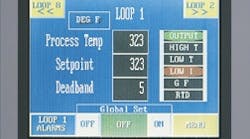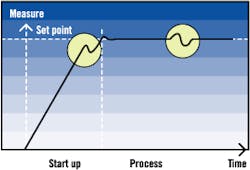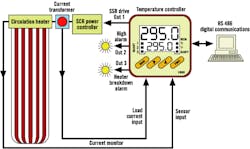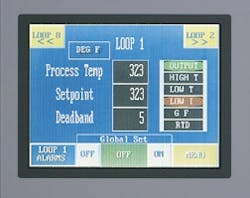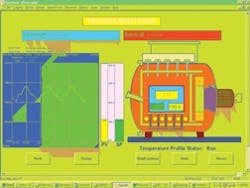Engineers responsible for chemical processes are learning that one easy way to improve product quality and increase yields is by tightening heating process control. In applications in which electromechanical thermostats control heating with simple on-off control, digital temperature controllers can provide fine temperature regulation, adjustable ramps for heat application and gradual cool-downs.
Digital temperature controllers have fallen in price, so an engineer can upgrade a control system with only a modest investment. What's more, sophisticated proportional-integral-deriviative (PID) controllers are available with push-button displays and Windows-compatible software, eliminating the need to write system control code.
Among the processes that can benefit from smart temperature controls are fermentation, petroleum refining, rubber production, polymerization and synthetic fiber production. Different types and levels of control intelligence are useful for different applications. Therefore, an engineer needs to know which smart control features will be most advantageous to his or her process, and which types of programming features best fit the plant's operating environment.
Selection criteria
Clearly, process plants must consider many features when selecting a digital temperature controller. But attention to process economics and application details help the specifier avoid overspending on intelligence features of marginal value.
Broadly speaking, "smart control" refers to digital controllers with features that go beyond basic open/closed systems. Smart temperature controllers can be programmed to provide a variety of outputs in response to changing conditions. Often this includes "predictive" logic that compensates for errors, load changes or thermal shifts. Auto-tuning of control loop PID coefficients and diagnostics for internal or external faults also might be possible.
Digital controllers might allow real-time sensing in the process loop, and provide electrical excitation for transducers. Of particular importance in process applications are controllers with alarm functions, as well as those with the ability to record or communicate event data such as temperature, date, time, channel number and alarms to other devices or to supervisory control software.
Reactor application
Consider a reactor application in a pilot plant, where various time and temperature recipes are being tested to arrive at optimal results. Some reactors require heat to start the reaction, so electric cartridge or insertion heaters often are used for this purpose. Once the reaction starts, the process could be exothermic.
Temperature control for such pro-cesses must be multifaceted. See Fig. 1.
Figure 1. Schematic of Process Heating Application
Temperature control for the type of process shown here must be multifaceted.
First, specific heating loop PID parameters are needed to bring the temperature up to the precise reaction point, without overheating and in the shortest practicable time. In this case, the engineer should select a controller that provides auto-tuning of PID coefficients to optimize convergence to the set-point temperature. See Fig. 2.
Once the reaction is going, it must be throttled back by a cooling loop, usually connected to the same controller as the heating loop. Typically, the engineer will want to program alarm conditions into the controller. He or she will need a control relay or digital output to open a valve that neutralizes the reaction if it gets too hot (Fig. 2).
Figure 2. Smart Self-tuning Set Point Convergence Curves
Smart self-tuning calculates DIN controller PID coefficients to optimize the rise to set point during startup and updates these parameters as needed to respond to set point or log changes during the process.
Resolution, accuracy and repeatability
The resolution, accuracy and repeatability of the controller are important considerations, and they, too, are driven by process requirements. A plastic injection machine, for example, does not require temperature control as precise as that required by a chemical storage tank. Typically, a digital controller's temperature accuracy is specified in terms such as (0.2 percent of span +1 least significant digit [LSD]). More precise controllers with a 0.1-degree precision are available for applications requiring tight temperature regulation.
Repeatability is key in all these applications. In other words, each time the controller is reset to a given temperature, an actual measurement will display the same temperature as the last time, within a narrow tolerance band. See Fig. 3.
Other temperature controller selection issues include physical size, the types of sensor inputs, ease of installation and power controller interface issues.
Upgrading to higher intelligence
Older temperature control systems commonly have a bulb and capillary sensing element that provides on-off control for a single loop. For process materials that tolerate wide temperature swings, this level of control might be adequate. However, these systems can be upgraded easily with new DIN temperature controllers, which provide much better resolution.
Many microprocessor-based DIN systems currently are available, most of which are easy to install and allow universal sensor inputs, including thermocouples, resistance temperature detectors (RTDs), voltage and current.
At one end of the range are controllers with little more than temperature control logic. The advantage of these controllers is their uncomplicated setup. The user simply selects the sensor type via the DIP switch, connects the sensor to the input and configures the temperature set point using push-buttons on the controller's front panel. These simple DIN controllers are good replacements for aging electromechanical systems.
More sophisticated DIN controllers offer general PID control algorithms that can be configured for applications beyond temperature, including pressure, flow and level control. In addition to allowing field setup via the front panel, some higher-end controllers include a data communication port for remote configuration from a host computer.
Intelligence features of the microprocessor might include auto-tuning of the PID coefficients and fuzzy logic to achieve minimum overshoot and/or minimum elapsed time to a stable set point. Other intelligence could include multiple interval ramp-and-soak programs for curing or environmental testing ," with multiple event control outputs, as well as timed output-power limits to protect processes.
Diagnostic intelligence might be available to troubleshoot internal problems and protect process loops from the harmful effects of external faults such as the opening or shorting of a control output or power control device. Other faults that might be identified include missing load power, open or shorted sensor and reversed sensor.
Although digital controllers offer a lot of features (even in a 1/16 DIN package size), many process applications might demand a more comprehensive array of intelligent functions. For instance, to achieve intelligent scalable systems, the latest heat-trace controllers use microprocessors and programmable logic controller (PLC) designs with built-in software and virtual control panel graphical user interfaces (GUIs) (Fig. 3).
Figure 3. Repeatability might be more important than absolute accuracy.
Heat-trace systems are used extensively in many chemical plants to maintain the temperature and viscosity of fluids being delivered to a process. Sophisticated multiloop controllers provide low hysteresis and a fast response. Besides temperature control, these "high-end" systems monitor cable continuity and heater current.
Multiloop DIN controllers might be sufficient if the heat-trace system does not have too many control zones, and if the engineer is willing to build his or her own system. DIN controllers are available that have been designed specifically for heat-trace applications, and many have input terminals to receive signals from a current transformer that verifies proper operation of the cable.
Communication and installation considerations
Process heating applications often are related to other steps in the manufacturing process. In these cases, the plant should be sure to select a temperature controller capable of digital communication with a central control system. The higher-end DIN controllers will have a serial data communication port that provides the gateway to an overall process system. The status of conditions and alarms can be monitored centrally, and the controller can be reconfigured remotely.
DIN controllers do not have the ability to log data, but they can communicate data to a central software system or to an industrial PC. Datalogging is particularly important for process applications, because trend analysis can allow fine-tuning of heating control parameters and assist in predictive maintenance programs. In addition, data collection might be needed to document compliance with safety regulations or quality assurance requirements.
Regardless of its sophistication, a digital controller is only one component of a complete heat control system. A complete integrated system includes circuit breakers and power switching mounted in an appropriate control panel. Panel builders, integrators and heating system suppliers can combine a digital PID controller, silicon controlled rectifier (SCR) controller and power distribution devices in a complete system.
Today, with the continual shrinkage of semiconductors and innovative heat-sink design, 100-amp, single-phase SCR power controllers are available in package sizes smaller than 0.5 cubic foot. Such developments are helping to shrink overall panel sizes to allow the panels to fit into places not previously possible. Modular designs allow these systems to be scaled easily to higher currents and a larger number of loops for almost any process.
Programming and integration considerations
Often, processes require quick operator decisions and local adjustments to keep production on track. Fortunately, digital controllers are available with touchscreen displays having virtual push-buttons and complete process information such as temperature set points, actual temperatures, loop status, input values, load currents and alarms. A GUI avoids the need for a bulky keyboard and minimizes the time required for operator training. Furthermore, plant personnel do not need to learn cryptic switch labels or write software code.
Pre-packaged temperature control systems cost much less and require less set-up time than PC-based controllers and conventional PLC systems.
If the standard interface is inadequate, it is relatively easy for plants to develop a customized control program using a low-cost Windows-based software development package. These types of packages are auto-configuring supervisory control and data acquisition (SCADA) programs that communicate with control and monitoring equipment such as temperature controllers.
Typical functions include the real-time posting of temperatures in a process diagram, virtual dials and controls, data/event logging, alarms and a recipe system. See Fig. 4.
Figure 4. Many temperature control systems offer optional PC software that allows engineers to build custom interfaces.
The goal should be to build an intuitive touchscreen GUI that allows system operators to use the system with minimal training. Software that comes with a controller usually includes a hardware driver that is pre-configured for that controller, simplifying system integration. If third-party software is used, the programmer or integrator must get the proper driver from the control manufacturer. Sometimes a suitable driver is not available, and custom code must be written and tested, adding cost and time to the project.
Hausman is product manager, standard controls and sensors for Chromalox in LaVergne, Tenn. She can be reached at (615) 793-3900, or via e-mail at mary. [email protected].
